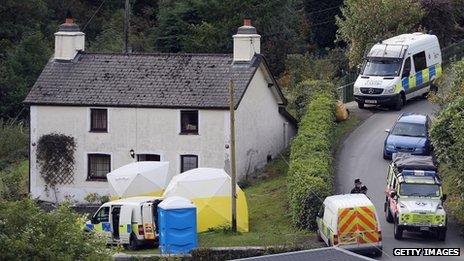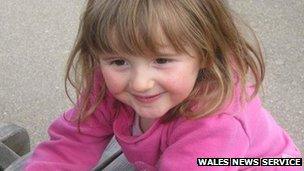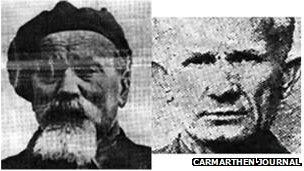April Jones: Murder trials without a body
- Published

Bone fragments were found inside Mark Bridger's house but he has not said where April's body is
Mark Bridger's conviction for murdering schoolgirl April Jones came despite the fact the five-year-old's body has still not been found.
For hundreds of years, people could not be tried in the absence of a body after a 17th Century case where the supposed victim reappeared after three people were hanged for his murder.
Now there are about two murder cases without a body each year in England and Wales. This is largely because of a law change following a murder case in Wales in 1954.
April, from Machynlleth in Powys, went missing on 1 October 2012.

April was playing outside her home with a friend when she went missing
Within 24 hours of her disappearance, police had arrested local man Bridger, 47.
He was charged with her abduction and murder five days after she was last seen.
During police interviews and throughout his four-and-a-half week trial, he stuck to his story that he accidentally ran April over and was so drunk he could not recall where he had put her body.
The jury was told fragments of bone consistent with a juvenile human skull were found among ashes in the wood burner at Bridger's home, along with April's blood near to a number of knives, including one which was badly burned.
The "no body, no murder" rule followed a legal case known as the Campden Wonder, external in 1660, where a 70-year-old man called William Harrison disappeared without trace from the town of Chipping Campden in Gloucestershire.
Mr Harrison's servant John Perry, his brother Robert and mother Joan were hanged for his murder in 1661 after John Perry incriminated his relatives.
But the following year, Mr Harrison reappeared, saying he had been kidnapped and sold into slavery in Turkey.
Cases such as this made any conviction without a body a potential miscarriage of justice minefield. And it was not until 1954 that the "no body, no murder" rule was effectively overturned.

Michael Onufrejczyk (l) murdered business partner Stanislaw Sykyt at the Cefn Hendre farm they co-owned
Michael Onufrejczyk, a Polish ex-serviceman from World War II, bought Cefn Hendre farm in Llandeilo, Carmarthenshire, after the war and in 1953 went into partnership with fellow Pole Stanislaw Sykut.
Police carrying out routine foreigner checks came to the farm in December 1953 to find Sykut gone. Onufrejczyk told them Sykut had sold him his half of the farm and returned to Poland.
But investigations showed Sykut had left £450 (around £10,500 in today's money) in a bank account and none of his friends knew he had gone. He had also made legal inquiries about dissolving the partnership.
Sykut had previously complained of violent behaviour by his partner. Police arrested Onufrejczyk and charged him with murder.
They were convinced he had chopped Sykut's body up and fed it to the farm pigs.
At the trial, the jury heard evidence of over 2,000 tiny human bloodstains found in the farmhouse kitchen. They did not believe his claim that the marks were rabbits' blood, caused when he skinned them.
He was convicted of murder and sentenced to death, later commuted to life imprisonment.
Just last year, married infrastructure manager David Gilroy was convicted at Edinburgh High Court of killing his lover Suzanne Pilley after she tried to end their relationship.
Ms Pilley went missing on her way to work in Edinburgh in May 2010.
After analysing in detail both of their movements on CCTV and building up a picture of phone calls and texts sent by Gilroy, police arrested him and charged him with her murder a month later.
Despite a lack of direct forensic evidence from the site, police believe he lured her to the basement garage at their shared place of work, killed her and hid her body in a stairwell before transferring it to his car and dumping it somewhere in western Scotland. It has not been found.
'Fairly confidently'
Dr Fiona Brookman, reader in criminology and deputy director of Glamorgan University's Centre for Criminology, said although no central statistics on the number of these trials were collated, research by the CPS suggested there were about two each year in England and Wales.
"There are up to five if you take the whole of the UK," she said. "It's not as rare as one might assume.
"There's lots of ways that you can fairly confidently prove that people are no longer alive."
She said changes in technology meant people left behind a trail which ceased rapidly when they were killed.
"Detectives have a patchwork of evidence that they can put together," she explained.

April was seen by her friend getting into Mark Bridger's Land Rover
"The body is a central piece of evidence but not critical. The victim's phone suddenly went dead - that's significant. The person's not seen on CCTV. Their bank account is not used.
"All these things show the person isn't with us any more.
"The body is helpful if you want to learn exactly how they were killed and if you want to find evidence from the killer on the body.
"Sometimes the body is not that important in an investigation, particularly if it's a domestic crime. There's always a lot of cross-contamination if the people are connected."
Dr Brookman added that in some cases the body may be discovered by chance after the killer had been convicted.
But, she added, there were many reasons why a killer may not choose to reveal its whereabouts - most obviously failing to accept responsibility or being in denial.
"It also could be about control," she added. "When you have been arrested and are in prison, the one thing you can control is information about that crime.
"Many people who commit crimes are not friends of the police and won't help them."
If the killer had committed a particularly heinous crime they also may not want the details revealed.
"In some cases the killer remains connected psychologically with the burial place of the victim and wants to keep it private."